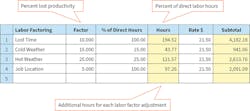Every electrical contractor knows (or should know) that the greatest risk in construction is labor. Many factors and conditions can cause a project’s labor productivity to be less than optimum. In turn, various projects have different factors that can lead to decreased productivity. Let’s discuss this important aspect of the estimating process.
Project labor factors are project conditions that impact productivity. These conditions affect labor productivity negatively, while these factors are percentage adjustments determined by the project conditions and added to the direct labor hours.
Project labor factor attributes:
- Are expressed in percentages
- Can be global, affecting the whole project
- May impact only a portion of the project
- Are based on geographic location
- Are determined by the project type
- Are governed by workers’ abilities
- May occur in multiples
- Are cumulative.
Project labor factors are addressed in the bid summarization. Quality estimating software should provide the estimator with the ability to make these labor adjustments.
As shown in the Figure below, you can view several project labor factors. Note that two factors (Lost Time and Job Location) are factored at 100%.
Each factor is expressed in a percentage of lost productivity to a percentage of the direct labor hours. For example, lost time for checking in and out of a correctional facility would be a percentage of time for each day for 100% of the project’s duration. Lost productivity due to cold or hot weather would only be a percentage of the number of hours required during inclement weather. For instance, if a 12-week project required three weeks of work during inclement weather, only the affected work hours would be factored in.
Adjustments are made in percentages to the direct labor hours. No two projects are the same, so be sure to consider all project labor risks and bid accordingly.
Consider the following 23 conditions and how they impact labor productivity:
1. Access to work area ― Manpower, materials, and equipment must be moved in and out of the work area.
2. Accelerated schedule ― When a project is accelerated, it requires a larger work crew. An accelerated schedule may also lead to overtime and/or multiple shifts.
3. Addenda factoring ― Addenda interrupt the flow of work. An addendum will distract the project foreman from the contract work.
4. Building construction ― If a building is spread over a large area, then labor required for handling materials and moving equipment increases. Odd-shaped or old buildings pose their own challenge. Buildings with more than three floors also will increase labor install time.
5. Crew size ― The larger the crew, the larger the risk for lost productivity. Depending on the crew size, non-working supervision may also be required. In addition, a larger crew means more tools will be needed.
6. Dusty environment ― Dusty environments can make working conditions miserable. Keeping tools and materials clean for installation is a challenge, and additional safety equipment will be required. Be sure you know OSHA safety regulations related to this type of project.
7. General contractor capability ― Subcontractors are at the mercy of the general contractor (GC). When the GC cannot keep the project on schedule, all subcontractors are affected. When the experience and performance of the GC are not known, caution must be exercised before entering into a contract.
8. Hazardous environment ― In hazardous locations, more safety precautions are necessary to keep workers safe. When working in an area classified as hazardous, you’ll be required to use special safety equipment and clothing. Restrictions may limit the time and exposure of workers to the area, resulting in less time on tools.
9. Isolated environment ― An isolated work site poses several risks. Health and safety for workers need to be considered. Examples of isolated work environments include mines, oil exploration, refinery platforms over bodies of water, and high-voltage transmission lines. In an isolated workplace, transporting injured workers to health facilities can create the potential for a basic injury to become life-threatening due to the distance. Also, communications in isolated environments can be limited.
10. Job location ― Projects located a distance away from the contractor’s office or the workers' homes pose extended travel periods to and from the project. Therefore, an allowance of lost time is necessary. For example, workers may want to get an early start on the weekend by leaving early to arrive home as early as possible. Furthermore, material deliveries and equipment transportation will impact the project’s productivity.
11. Multistory impact ― The higher the building, the higher the labor costs. Labor units typically cover a building up to three floors. As a rule of thumb, this factor will be at least 1% per floor with a cumulative total. Furthermore, it will depend on the number of construction elevators, project schedule, crew size, and staging area.
12. Non-local manpower ― If the contractor must use workers from outside the project’s immediate geographical location, issues could arise regarding their skill level and abilities.
13. Occupied facility ― An occupied facility typically slows workers’ progress because it involves additional clean-up as well as covering existing equipment and/or working around it. If the facility operates 24 hr a day, then personnel and their operations obviously become another factor.
14. Overtime ― An extended overtime schedule can impact labor costs significantly. Overtime not only produces physical fatigue, but also may also negatively impact workers’ mental attitudes. Both lead to decreased productivity. The longer the overtime schedule, the greater the loss of productivity.
15. Phasing by area, floor, or building ― When a project is broken down into phases and those phases are sequential, it requires mobilizing and demobilizing.
16. Poor electrical design ― Poor drawings and specifications are detrimental to efficient production.
17. Renovation ― Renovation is more labor-intensive than new construction because it requires more coordination with all trades. Furthermore, unforeseen issues will be likely be discovered and must be brought to the owner’s attention. This results in delays and waiting for direction from the architect.
18. Shift work ― When one crew takes over for another, time is lost because project information must be communicated to the incoming workers. Material handling labor also increases with multiple shifts. Supervision hours increase as well because two foremen must meet to coordinate the transition from one shift to another.
19. Stacking of trades ― The stacking of trades describes conditions where multiple tradespeople are working simultaneously in the same location. Having too many workers in one area reduces labor productivity.
20. Staging location ― When materials are stored away from the work area, extra labor is needed to handle equipment and bring materials to the worksite.
21. Weather conditions ― This factor is dependant on the contractors’ geographical location, and often reduces labor production. In cold weather, workers tend to retreat to warmer areas; in hot and humid weather, workers will find a place to cool down. Additionally, excessive rain can pose problems for outdoor work — especially underground work.
22. Work conditions ― Both morale and productivity can be affected when workers are exposed to one or more of the following:
- Excessive noise levels
- Unsafe working conditions
- Inadequate tools
- An untidy construction site
- Inadequate or incompetent supervision
23. Work experience ― Skilled workers are necessary to complete a timely project. Knowing the skill and abilities of your workers is vital because not all electricians are created equal.
Things to keep top of mind
Be thorough in labor factor assessments. All of these can have a significant impact on the labor production rate. Always remember, the greatest risk in construction is labor.
Don Kiper is an independent electrical estimating trainer and consultant based in Niagara Falls, N.Y. He can be reached at [email protected].




